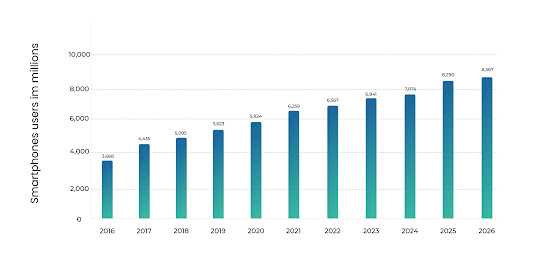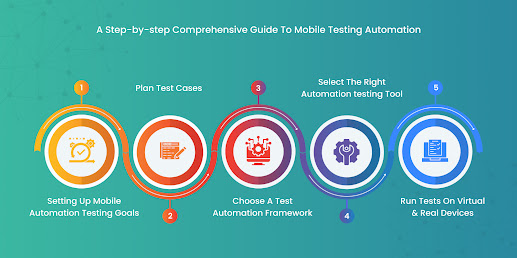
The global market of mobile apps is growing more than ever. The number of smartphone users has surpassed 6 billion. This number can increase by several hundred million in the next few years. And CAGR is expected to reach 8.6% between 2023 and 2033.

With the growth of technology, mobile app businesses are becoming smart. They have high expectations with zero tolerance for bugs and performance issues. A report says that 25% of apps were used only once after development.
Every mobile company has to consider its users and their needs before designing and developing any feature-rich app. They have to ensure that the apps developers are developing are user-friendly and give customers a great user experience.
If users' experience is not good, they will not consider buying or using the apps created by your company.
One of the main reasons behind mobile app abandonment is poor user experience. It can be because of confusing UI/UX designs, bugs, slow load time, etc. To ensure that the app you are building meets the user's needs and performs seamlessly on iOS and Android, you must run testing continuously. However, mobile testing is a complicated process, and mobile automation tools are helping businesses to make the process easy.
Moving further in the article, we will discuss best practices that help you select the best framework for mobile app testing.
Difference between Manual and Automated Mobile App Testing
Manual Mobile App Testing: In manual testing, developers test the features, functionality, and compatibility of the application against different test cases and across multiple devices.
It is a time-consuming, intense, and prone to human error process. Also, it becomes difficult to scale the functionality if applications become more complex with regular updates.
Automated Mobile App Testing: In automated testing, developers or testers use specialized tools to manage and control test cases. It is a time-saving process, as test cases take less time.
It works seamlessly for large projects that involve repetitive and continuous testing of pre-written scripts.
It is an ideal testing tool that offers the advantage to run multiple tests across different components and mobile frameworks simultaneously. Automated testing uses an Agile development testing process, which focuses on continuous, early, and iterative testing to find and fix development issues.
Not only that, it tests the performance in the early stage of development and improves the quality and efficiency of mobile app testing.
Businesses should consider the test cases that will be able to answer the questions such as:
Is it possible to automate this test case?
Will automating this test case save me time?
Is automation going to improve the quality and performance of the app?
A step-by-step guide to Mobile Testing Automation

Step 1: Setting up mobile automation testing goals
Software testing is one of the most crucial steps in the app development process. It helps you understand whether the app is working as required or not.
If the app is working great, it is known as positive testing. However, if an app works unexpectedly or shows errors, is called negative testing.
Now the question is, how can you test mobile apps?
The mobile app development process is similar to that of mobile app testing. Developers can leverage the potential of unit tests. They help developers ensure that their applications run smoothly and meet all their needs.
Step 2: Plan test cases
The types of test cases that can help you in the development process are outlined in the Agile testing matrix/testing quadrants.
Testing is an integral part of Agile sprint and must be done at every step of the development.
As you can see from the matrix, business-facing or customer-facing tests in quadrant 3 (Q3) require a lot of manual testing. However, Q1 and Q2 are open to automation. For proper automation, the test case must be:
- Repeated often or must be repetitive
- Involve time-consuming data entry
- Subject to human error
- Low risk
- Easily measured/objective
But if in any case, your test case relies on subjective feedback e.g. UI/UX, or requires many steps, it is likely not to good fit for automation.
It is recommended not to write automation codes for the cases where you need to test only once. Automation is a time-consuming process, so it must be written only for the cases where developers need to run the test cases again and again. Now let us discuss the types of test cases, that are most common to use to automate mobile app testing.
> Types of test cases to automate
1. Unit Testing: Unit testing is an Agile testing process. It checks the quality and efficiency of features added or developed by the developers and is called the white box test, the smallest unit of testing. It ensures that each feature works properly from both a technical and design perspective. Developers run these tests on both iOS and Android to check the dependencies. Unit tests are cost-effective and can easily check the operation and functionalities of the features added. Also, these tests ensure that your application has a solid foundation and seamless user experience.
Let us see an example: When a signup or login functionality is added to the app, developers run the unit tests to check if the app is working as required or not. They may consider looking at the field length, characters, error messages, login, sign-up field, or whatever field or functionality is needed to check.
The need to automate unit tests: The main focus of unit tests is on remote codes which use more frameworks. These codes are then tested on multiple mobile frameworks and unit tests check if the codes are working as required or not. Unit tests are easy to run and help in fixing issues quickly.
2. Integration Testing: Mobile app development is not simple. You can encounter cases where few functionalities do not combine or if somehow combined, they can generate errors. The integration tests check the system-wide performance and check if all the units in the development are working properly or not.
Let us see the example: Consider that you are creating a login functionality for a user. You need to combine the functionality with the database authentication. The integration test will do this for you. It is a process that connects with the database to verify authentication works. But it does not verify that you reach the next step which can be the welcome page or login error screen.
The need to automate integration testing: Integration testing has dependencies like databases, but the tests are simple and focused and ensure that newly added functionalities do not cause performance bugs.
3. Functional Testing: Functional testing is a form of black-box
testing. In this type of testing software system is tested to make sure
that the system meets the functional requirements. This includes
checking the database, client/server communications, user- interface,
APIs, and more. It checks the outputs, accessibility, performance, and
error conditions of the tests.
Let us see the example: Functional testing takes care of the desired outcome: Was the login successful? Did the welcome message appear? Is the input correct? Does the user get the reset password option? Does the error indicate that the files entered are wrong? Every test case and scenario is considered.
The need to automate functional testing: Functional testing measures the performance against a predefined requirement and is easy to automate as the mobile app evolves. But the complex functions are not captured using functional testing.
Step 3: Choose a test automation frameworkAfter test case identification, you need to choose the right automation framework. It is an integrated system that is responsible to make rules for automation for your test. This is the best way to review and create your tests. With that, let us look at the six top frameworks for mobile app testing automation.
> Types of mobile automation framework- Linear automation framework: The linear automation framework is also known as the record and playback model. It is a linear model and incremental and ideal for simple applications or unit tests.
- Modular-based testing framework: In a modular-based testing framework, scenarios are created and the modules can be combined to create larger testing scenarios.
- Framework for testing library architecture: This framework is similar to the modular-based testing framework, but instead of modules, developers group common tasks into functional groups. These functions are then stored in a library, which can further use as a reference to create test cases. This framework makes it easy to reuse test cases.
- Framework data-driven: Data-driven framework tracks the data. In this, the tests may remain the same but the data might differ. It is highly effective in pulling data out of external systems.
- Keyword-driven framework: Keyword-driven framework is also known as table-driven. It pairs with the external test data in tables such as Excel and allows the creation of a table-driven framework. Even though the different test scripts can use similar keywords, the framework can take a lot of time to set up.
- Hybrid testing framework: A hybrid testing framework refers to two or more of the above frameworks. These allow teams to create an ideal test environment.
Step 4: Select the right automation testing toolMobile automation testing tools help developers create scripts using a test automation framework.
It is crucial to select the right automation tool, even if the developers do not have detailed knowledge of all the frameworks. Having a basic understanding of the frameworks can help you choose the right tools for the job.
The factors to consider when choosing a mobile app testing tool.
- OS support (iOS / Android / Windows).
- Types of tests supported: unit tests, regression tests, functional tests, etc.
- Cost and scalability.
Here are a few top mobile testing tools to choose from:
- Appium
- Google Espresso
- XCTest and XCUITest
- Quantum
- Robotium
Step 5: Run tests on virtual and real devices
It is crucial to run the test cases on virtual and real devices to check the robustness of the apps. The virtual and real devices include the OS and the hardware, respectively. Developers can run the test case on multiple ranges of mobile devices and configurations. And app testing should be done on the gadgets that are used by customers on daily basis. These gadgets include the latest iOS gadget, top Android telephones, and more.
To conclude:
A great mobile app is a blend of designing and testing and offers an excellent interface, visuals, and seamless user experience. Hence evaluating the app's performance, functionality, and scalability is crucial for any mobile app business. Test cases are critical for any development process, and developers can start creating them before the development process of the mobile apps.
It allows you to test your mobile app quickly and efficiently and is a highly time-saving process. You will be able to know the issues in advance and will be able to fix the bugs on time and make sure that you create great and organized test cases. It helps you integrate feedback faster and focus on improving the apps, which can help your business grow globally. Also, it is necessary to take the help of professionals who are well-versed in developing mobile apps and test cases. They can help you make user-friendly apps that can help you get more sales and increase your revenue.
So, if you are searching for the perfect and the most reliable mobile app services, ToXSL Technologies is here to help you. We have experts who have helped many customers globally by creating the most user-friendly, responsive, high-quality, and bug-free apps.










